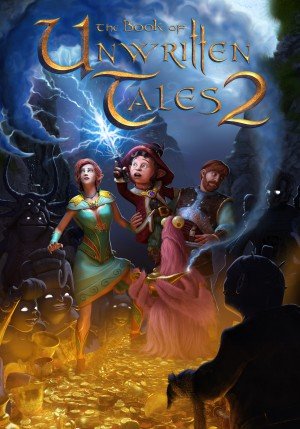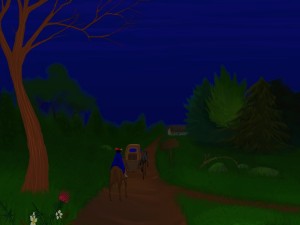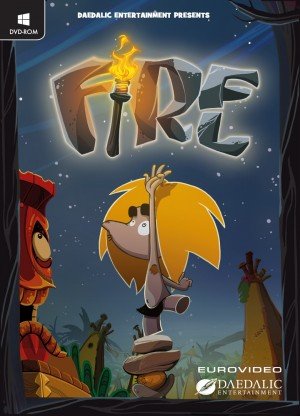Fragments of Him archived preview

SassyBot Studio's Fragments of Him, releasing soon for Windows and Xbox One, may or may not be a game—and narrative designer Mata Haggis is okay with that. “We are entirely expecting people to say ‘this isn’t a game,’ and that’s fine. I respect that they feel that way. I’m not even sure I entirely disagree with them,” he told me when we met at last month’s Game Developers Conference. “I hope these people are also going to go, ‘Okay it’s not a game. What is it?’ Whether it’s a game or not, I hope people show enough interest in seeing an experiment like this to at least give it a try.”
‘Experiment’ is a good word to describe Fragments of Him, a roughly 2½ hour experience that has the vibe of an art-house film. “Basically, Fragments of Him [explores] love and memories through the eyes of four characters,” Haggis explains. “It centers around the life of Will, who’s a young man who dies in an accident, and as we go through the events surrounding the end of his life we also have memories of Sarah, his girlfriend in university, of [his grandmother] Mary, and we also have Harry, who was Will’s boyfriend at the time of the accident.”
After playing a 40-minute demo that introduced two of these characters and gave glimpses of the others, I think the price of admission needs to include a box of Kleenex. “It does have sad moments, of course, but really it’s about exploring love, the meaning of being in love with somebody else,” Haggis says. “And though there is grief, obviously—because [part of] going through that process of grief is coming out on the other side—it’s not like the game ends there, at the lowest point. It’s about finding meaning in having been that way with somebody, having opened your heart to somebody. Even if it was for a short amount of time, love was worth it.”
One of Sarah’s lines during the demo stuck with me: “Did you ever have a love that you felt so strongly, you knew it had to end?” A sense of doomed inevitability seems pervasive in Fragments of Him, and not only because we know Will’s going to die. Sarah loves Will, but Will loves Harry—an age-old tale with a twenty-first century twist. “For me it’s just about creating the most interesting experience,” Haggis says of his characters. “Sometimes the best story you could possibly tell for that experience is going to be a straight, white, cisgendered, middle class guy, and that’s fine. If that is the best character to tell your story, tell it with that character. But sometimes it won’t be. Sometimes it will be a bisexual guy. Sometimes it’ll be a woman of color. Sometimes it’ll be a transgender character, or a person who has PTSD after being in the war. These bring in factors that can actually become inspiration for gameplay, inspiration for mechanics, inspiration for scenarios. We can [turn] that game into an even more exciting world, an even more engaging world.”
It certainly is an unusual world, but that has more to do with its presentation than the story being told. First- and third-person viewpoints are mixed—sometimes you’re moving and seeing through the eyes of the playable character, but then you click on something and the character appears before your eyes as if he or she has just climbed out of your body and into the scene. Other times, the character stands frozen within the scene waiting to be clicked on; when you do, the character fades out and reappears, slightly farther away, enticing you to follow. At the bar where Sarah first seeks out Will, you must click on clusters of people to make them disappear so you can find him. Later, the restaurant where their relationship takes a sad turn starts out as a barren room that fills in with diners and furniture as you click to fill in empty areas. You can interact with the world using a gamepad, a combination of keyboard and mouse, or the mouse only based on personal preference.
Interactivity provides some of the game’s only color: as you approach something you can click on, a blue outline turns yellow to indicate you’re now close enough to “use” it. “We’re trying to look at the ways we can use one really simple mechanic, which is walk around a space and click on stuff that’s highlighted, to create all sorts of different meanings with the result of that click,” Haggis explains. But in this narrative experiment, even clicking on hotspots doesn’t have the usual effect—more often than not, clicking an outlined item simply prompts the character to relate a memory that serves as the next sentence in the story they’re telling, possibly not even related to whatever you clicked on.
Fragments of Him’s minimalism carries over into its aesthetics. The world isn’t exactly black-and-white, but it’s devoid of color, and many of the people only appear as gray silhouettes. Even the more fully formed characters are faceless, their features only hinted at. “The four faces of the main characters are unique and all individually crafted to fit their age and demographic and all these things,” Haggis points out. “But they are blank, and the first time people see them, people kind of go, ‘Oh, that’s weird,’ and then they sort of pause for a sec, and they go ‘Okay, that’s what it is’ and they move on. They don’t try to pick holes in it. If the world didn’t look right, you’d pick holes in it.”
Similarly the environments, though detailed, are also stark—as if the artists have yet to take a final pass to add texture and color. “There’s quite a few different reasons for this art direction. Some of them are very practical. We’re trying to create a whole world with a large number of locations—a whole chunk of London is the very first five minutes. You would be mad to try to make that photorealistic,” Haggis explains. “But you also want people to know it’s the real world. So we’ve got this style that’s halfway between the two: it’s realistic enough that you know that’s a TV, that’s a painting. By choosing this [style], we’ve reduced a bit of the artwork load that needs to be done, but I think we’ve also left a potential emotional space. We’ve left the space for imagination.”
Some of these decisions may have been practical ways of dealing with a small team and small budget, but they just happen to support the theme of reliving one’s memories. “This game is a work of narrative design, and so everything in here is about narrative. The choices about the aesthetics… from the very first day I said I want to do this in simple, plain textures as much as possible, black and white,” Haggis says. “These are people going through very serious emotional experiences. I don’t want this to be bright and colorful, don’t want the colors to distract us from that experience.”
This attention to theme doesn’t extend only to choices about colors and character design. Every detail in this world has been deliberately placed to help tell Will’s story. “By choosing to have those table legs, I’ve told you a little about the people who live there. By choosing that style of lamp, I’ve told you a little about the people who live there. Everything about this is to compact as much about the lives of these people into this space as possible, so I don’t have to write you pages of dialogue,” Haggis says. “If you know who Will and Harry are [from] looking at their room, these are spaces we can use as visual language to tell you the emotions, the feelings, the nature of the character, the influences these people have in their lives.”
But while there may be narrative breadcrumbs crammed into every nook and cranny, Fragments of Him is not a hugely interactive story—at least, not in the way players of adventure games are used to. “You can’t save Will,” Haggis warns. “The things you can click on will be the same [from playthrough to playthrough]. There are choices within the dialogues—a lot of those choices are made by the computer for you, so you heard lines of dialogue [the first time], the next time you play some of those lines you’ll hear again, sometimes you’ll hear a different line. There’s one particular conversation where you can choose your path, but it will always end up in the same place. It’s about allowing a little bit of flexibility within the space of that [character’s] memory, within the space of what was possible in that reality. And always bringing it back to the heart, the emotional truth of what happened.”
Haggis first experimented with Fragments of Him at a weekend game jam almost three years ago. “I had an idea about making a game about the end of a relationship, and I wanted to [explore] how games can deal with real life issues,” he explains. “The theme of the jam was minimalism. I had this picture of a man sitting alone in his apartment, all the objects have been stripped away, and the question was, why would you take everything out of your life? And the answer was that all his objects bring up memories that are too painful to face up to. From that point onwards, you go forward and backwards in time to find out how he reached that state, what happened before.”
 |
L-R: SassyBot's Mata Haggis, Tino van der Kraan and Elwin Verploegen |
The result of that weekend game jam—a vignette focused on Harry’s experience after losing his partner—had an unexpected impact on the people who played it. “We had emails from all across the world telling us ‘This is beautiful, I’ve just been crying my eyes out, thank you so much for making this.’ And those kinds of stories kept on coming for the next six months. People were writing to us saying, ‘My father died a couple months ago, I’m not at the end of this process yet, but playing this game has made me see that there [will be] a point at which the love I felt doesn’t hurt me every time I think of it.’ And so—even though it was a gay relationship—we did find that the emotions, the truth and honesty of grief and also of love, is a universal thing speaking to lots of people in lots of different ways.”
Though it shares elements with another recent project about heartache, Fragments of Him started development long before Haggis played That Dragon, Cancer. “I really respect what [Ryan and Amy Green] have done, taking such a raw part of their life [the illness of their son] and turning it into an experience that other people can share and hopefully be inspired by,” Haggis says. “Personally, I was more inspired many years ago when I played Dear Esther the first time—the Half-Life 2 mod; I played it at that stage, before it got remade. Just the absolute stripping away of all gameplay mechanics to the most basic thing of just walking along, and still managing to create something that was moving, still creating something that was powerful.”
Which brings us back to the question of whether Fragments of Him, with its total emphasis on narrative and extremely minimal interactivity, should be considered a game or something altogether different. Haggis suggests that a better way to describe it is “a night out at the theater … you can go see the same show tomorrow, slightly different, but you basically see the same show.” Though he does think interactivity—putting the player in these characters’ shoes—is critical for delivering the emotional impact of the story he’s trying to tell, the inability to change the outcome is also important: “We had a lady play this at gamescom a couple years ago; she played the very first demo we made, and towards the end she said ‘I want to be able to throw myself out the window. My character’s very sad, I should be able to throw myself out the window.’ That’s not his story, that’s not what he would do. That’s what you as a player would do. The player goes, ‘Oh yeah, suicide, that’s the easiest way out of this problem,’ [but] this is a journey. You don’t solve a journey by taking a shortcut, you go on the journey. You have to go on this journey with [these characters].”
Why should we, though, when that journey is clearly so sad and painful? “I think that all of us, if we live long enough, will have this happen to us sometime—that moment of a person that we love just being gone—and I think it’s important that games can deal with this kind of thing,” Haggis says. “It’s an important part of the expression of commonality that all humans have, to be able to explore these things through our creative medium. And games are a creative medium—alongside paintings, alongside books, alongside theater. Games can explore these things, too.”

















